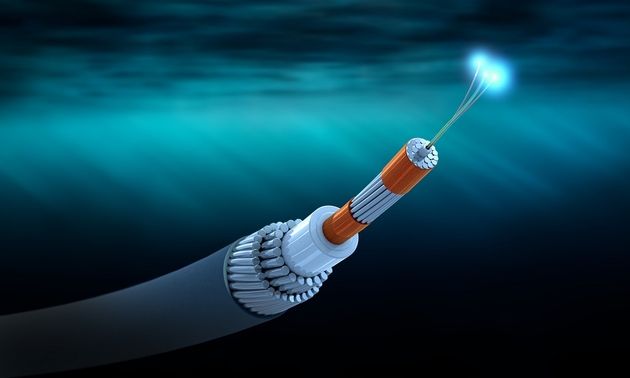The Houthis will have carried out their threat. According to the Israeli newspaper Globes, four submarine communications cables located between Saudi Arabia and Djibouti have been taken out of service.
Earlier, Yemeni rebels and other factions close to Tehran had threatened on Telegram to sabotage these telecoms infrastructures passing through the Red Sea, one of the backbones of the global Internet, a passageway between Europe, Middle East, Africa and India.
But the Middle East is not the only sensitive area on the globe. The war between Russia and Ukraine, the growing tensions between Beijing and Washington and China’s desire to invade Taiwan are all favorable grounds for this type of malicious act, in the Baltic Sea or the China Sea. .
The invisible war
For Recorded Future, a cyber threat intelligence platform, state actors constitute the main threat of sabotage or intentional cutting of submarine cables, due to their action capabilities (submarines, fleets of ships) and their aims. geostrategic.
Hacktivists or ransomware gangs are coming in behind. While frequent, accidental damage caused by civil navy anchors or fishing vessels, on the other hand, has a low impact.
Real “ information superhighways supporting the global economy », submarine cables represent attractive targets for intelligence gathering or sabotage explains Recorded Future in a report. Used for more than 170 years to establish international communications, submarine fiber optic cables laid on the ocean floor represent “ approximately 99% of intercontinental internet traffic. »
GAFAMs exposed
“If data is the lifeblood of today’s digitized world, then submarine cables are the vital arteries that support it,” continues Recorded Future.
Our dependence on this invisible infrastructure only grows with the digitalization of the economy and society. Even American cloud hyperscalers Amazon, Google and Microsoft are exposed to this geopolitical threat.

Exclude “high risk” suppliers
This threat has not escaped the notice of the European Commission. In a recent recommendation on the security and resilience of submarine cables, it calls for the greatest vigilance. Each member state is invited to map potential risks and include the protection of underwater communications infrastructure in its national cybersecurity strategy.
In accordance with Article 23 of the NIS 2 Directive, incidents affecting submarine communications cables must be reported to the Computer security incident response team (CSIRT) or to the competent authority. Brussels is also calling for synergies at the level of the European Union and to strengthen its cooperation in the field with NATO.
The European Commission recalls that these critical infrastructures are not limited to cables but also include repeaters for their power supply and terrestrial installations such as landing stations. Their construction, operation, maintenance and repair “ should be considered to be of major public interest.
Towards the implementation of stress tests
To guarantee the highest level of protection, the recommendation mentions in particular the physical and logical redundancy of infrastructures, the presence of sensor and monitoring systems and a strengthening of the capacity of the fleet of vessels dedicated to the deployment and maintenance of cables.
The European executive encourages member states to regularly subject entities operating submarine cable infrastructures to stress tests. “ Such stress tests would make it possible to assess the resilience of entities according to different scenarios. »
Last but not least, States must exclude service providers or suppliers to “ high risks » from their markets for reasons of national security. Without naming them, the European Commission has its sights set on Chinese equipment manufacturers already on the verge of being banned from 5G networks. According to EuroactivHuawei subsidiary HMN Tech could be restricted or banned from deploying submarine cables in European seabeds.
China’s growing ambition
If the three main manufacturers of submarine cables are American (Subcom), French (Alcatel Submarine Network) and Japanese (NEC Corporation), the ownership of the installations, their operation and their maintenance are more distributed. According to Recorded Future, China has heavily invested in the field. HMN Tech now has 10% of the cable laying market and three state-owned telecom operators – China Mobile, China Telecom and China Unicom – have stakes in nearly 40 cables.
If China has historically focused on laying cables around mainland China, Hong Kong and Taiwan, the Middle Kingdom has expanded their deployment globally, and more particularly in Southeast Asia , in the Middle East and Africa, as part of the technological component of its so-called “Belt and Road” strategy.
Recorded Future notes that the Australian government in 2018 ousted Huawei from a cable project linking Australia to the Pacific island countries. In December 2021, the US Department of Commerce placed HMN Technologies on a blacklist.
Collection of information
In June 2020, a government agency recommended denying a request from Meta and Google to connect Los Angeles to Hong Kong via the Pacific Light Cable Network (PLCN), risking making Hong Kong a key digital traffic hub.
“ Alongside its advancement in cable production and deployment, China has sought to expand its participation as a cable owner/operator across the world.. » For Recorded Future, this paradigm shift gives it “ greater ability to dictate where and how submarine cables are deployed “.
This growing ambition supports “ most likely geopolitical ambitions [de la Chine] while creating new opportunities for intelligence gathering via the landing stations she controls. » « This expansion has also given Beijing greater ability to shape the physical structure of the Internet, and potentially corresponding digital behavior. »
Card: Recorded Future
